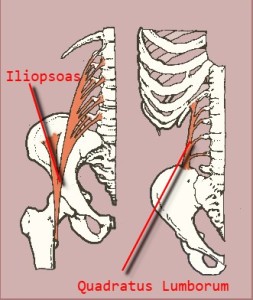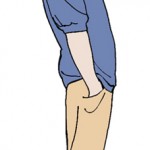
The psoas major and the quadratus lumborum are next door neighbors and you know how it can be if two neighbors don’t get along.
In fact, to continue the image, they share a driveway which as you might imagine can really complicate things.
The psoas major is my favorite muscle and I consider it to be the most important muscle in the body.
The psoas is the engine of walking and a warehouse for trauma which makes it very important indeed.
Its next door neighbor the quadratus lumborum has a much different nature.
It bends the body sideways and back up towards the mid line, and while important, doesn’t carry the same weight as the psoas major.
But, as is the case with the psoas’ sister muscle the piriformis, you can’t have problems in one without have problems with the other.
The psoas major attaches at six points inserting on the back half of the inner thigh at its base and then moving forward to cross the rim of the pelvis before moving back towards the spine and up, connecting on all of the vertebrae of the lower spine (lumbar) as well as the bottom vertebrae of the middle spine (thoracic).
It connects on each of these vertebrae on the front of the body of the vertebra as well as the costal processes.
The costal processes are the little jutting bones on the side of the vertebrae that you can see in the picture above (The psoas major doesn’t attach on the costal process of the bottom thoracic vertebrae, only on the body).
The quadratus lumborum originates on the top of the pelvis and connects the pelvis to the rib cage with its attachment on the top ridge.
In between, it attaches on the same costal processes as the psoas major.
So while these two muscles have completely different functions their mutual connections (the driveway they share) marry them for life.
It is our belief that though the psoas major is the body’s most important muscle, there are a host of other muscles that are profoundly affected by its troubles and quadratus lumborum, along with piriformis, are the two most important muscles that are affected.
It is a chicken and egg equation but say that the psoas major is tight pulling the lumbar spine forward into an excessive curve.
That forward pull takes the quadratus lumborum with it and it will no longer be able to function optimally.
Teaching people to stand and walk correctly I focus a lot of attention on the psoas major but in almost every case the quadratus lumborum is habitually and chronically tight and fights hard to maintain its long held position.
And its long held position is the problem that is pulling the guy in the picture below into his problematic leaning back posture. We think this is due in large part to an underused psoas major and a chronically tight quadratus lumborum.

